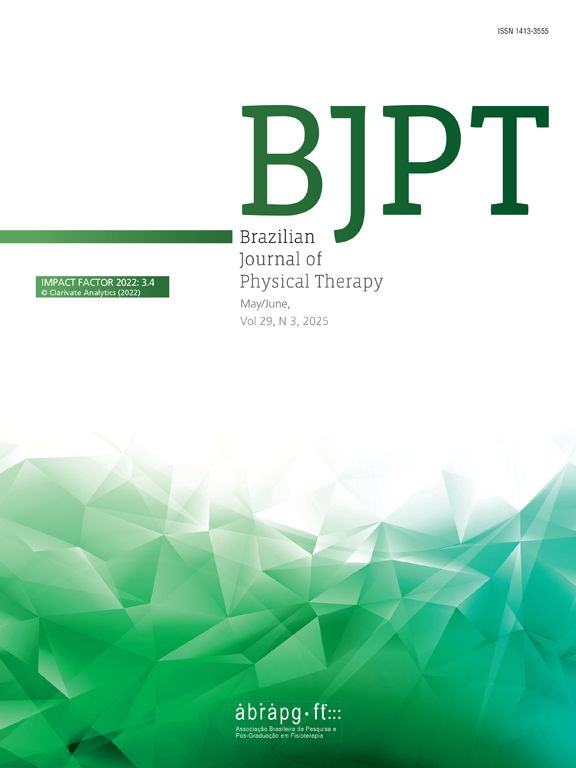4125
ASSOBRAFIR clinical practice guidelines in respiratory physical therapy: Exercise-based interventions in people with chronic obstructive pulmonary disease (COPD)Carlos Augusto Camillo, Valéria A Pires Di Lorenzo, Carla Malaguti, Celso Ricardo Fernandes de Carvalho, Ercy Mara Cipulo Ramos, Fábio de Oliveira Pitta, Marcelo Velloso, Nidia Aparecida Hernandes, ... Fernanda C Lanza
Braz J Phys Ther. 2026;30:101539
4125
Highlights
- •
It is suggested to use combined training (aerobic + resistance) over aerobic training alone in people with COPD. (conditional recommendation, very low certainty of evidence).
- •
It is not suggested either for or against adding IMT, NIV, or supplemental oxygen to combined training (aerobic + resistance) in people with COPD. (conditional recommendation, moderate to very low certainty of evidence).
- •
It is suggested to use either interval training or continuous training in people with COPD. The committee was unable to recommend for or against the use of partitioned training and nonlinear training in people with COPD. (Conditional recommendation, moderate to very low certainty of evidence).
- •
It is suggested to use maintenance exercise programs for people with COPD as an alternative to usual care after pulmonary rehabilitation programs. (Conditional recommendation, very low certainty of evidence).
- •
It is suggested to use minimal resource exercise training (especially with elastic resistance) in people with COPD as an alternative to conventional training. (Conditional recommendation, very low certainty of evidence).
3674
Dry cupping therapy has no effect on pain, function, or quality of life in women with knee osteoarthritis: Randomized placebo-controlled trialRacklayne Ramos Cavalcanti, Hugo Jario de Almeida Silva, André Pontes-Silva, Mariana Arias Avila, Clécio Gabriel de Souza, Catarina de Oliveira Sousa, Rodrigo Scattone Silva, Germanna Medeiros Barbosa, Marcelo Cardoso de Souza
Braz J Phys Ther. 2026;30:101259
3674
Highlights
- •
Clinically, dry cupping therapy is often believed to reduce pain and improve functional capacity in patients with knee osteoarthritis.
- •
Dry cupping therapy was not superior to sham cupping for women with knee osteoarthritis.
- •
Dry cupping therapy and sham cupping showed similar and small within-group improvements in pain, function, and quality of life.
1474
Referral of people with low back pain to physical therapists in Brazilian primary healthcare: A challenge revealedTais Luciana Lacerda, Pedro Lacerda Montes, Luciana Gazzi Macedo, Raymond Ostelo, Henry Maia Peixoto, Rodrigo Luiz Carregaro
Braz J Phys Ther. 2026;30:101538
1474
Highlights
- •
From a national primary care perspective, around 1 % of people with LBP were referred to physical therapy.
- •
The amount of time between referral and being seen by physical therapists ranged from 17 to 261 days.
- •
The overall rate of physical therapy visits to manage LBP was 1.28 per 1000 people.
1205
Effects of behavioral treatment and pelvic floor muscle training on overactive bladder syndrome: a randomized control trialMayanni Magda Pereira Matias, Fátima Faní Fitz, Márcia Maria Gimenez, Letícia de Azevedo Ferreira, Maria Augusta Tezelli Bortolini, Rodrigo de Aquino Castro
Braz J Phys Ther. 2026;30:101541
1205
Highlights
- •
BT with PFMT are important techniques in the treatment of women with overactive bladder. The combined therapy plays a fundamental role in improving irritative urinary symptoms and PFM function.
- •
Patients' motivation and adherence to BT and PFMT are essential for therapeutic success.
- •
BT with PFMT are easily reproducible non-invasive interventions, being the first-choice treatment for OAB with proven efficacy, and low cost and risk for women.
1129
Patient-targeted smartphone applications for pain management: A review of brazilian app marketsCaroline Maia Neves Favrat, Jessica Fernandez, Leandro Calazans Nogueira, Ney Meziat-Filho, Felipe J.J. Reis
Braz J Phys Ther. 2026;30:101262
1129
Highlights
- •
Physical activity and pain diaries are the most common contents in reviewed apps.
- •
Most apps lack professional details and science-based evaluation.
- •
Few apps are free, posing potential cost barriers for pain management.
- •
Many apps focus solely on single pain management approaches.
41
Assessing postural balance for predicting falls in individuals with Chronic obstructive pulmonary disease: A prospective cohort studyBárbara Aparecida Teodoro Alcantara Verri, Caroline Maschio de Censo, Juliana de Melo Batista dos Santos, Rafaella Fagundes Xavier, João Marcos Salge, Regina Maria Carvalho-Pinto, Celso Ricardo Fernandes Carvalho
Braz J Phys Ther. 2026;30:101557
41
Highlights
- •
Individuals with COPD have a higher fall risk, but studies predicting falls are scarce.
- •
Falls were associated with greater center of pressure displacement post-effort.
- •
The more challenging the assessed postural balance, the better the prediction.
- •
Mini-BESTest scores did not reflect fall history in moderate-to-severe COPD.
- •
Challenging balance tests seem to better identify fall risk in severe COPD.





